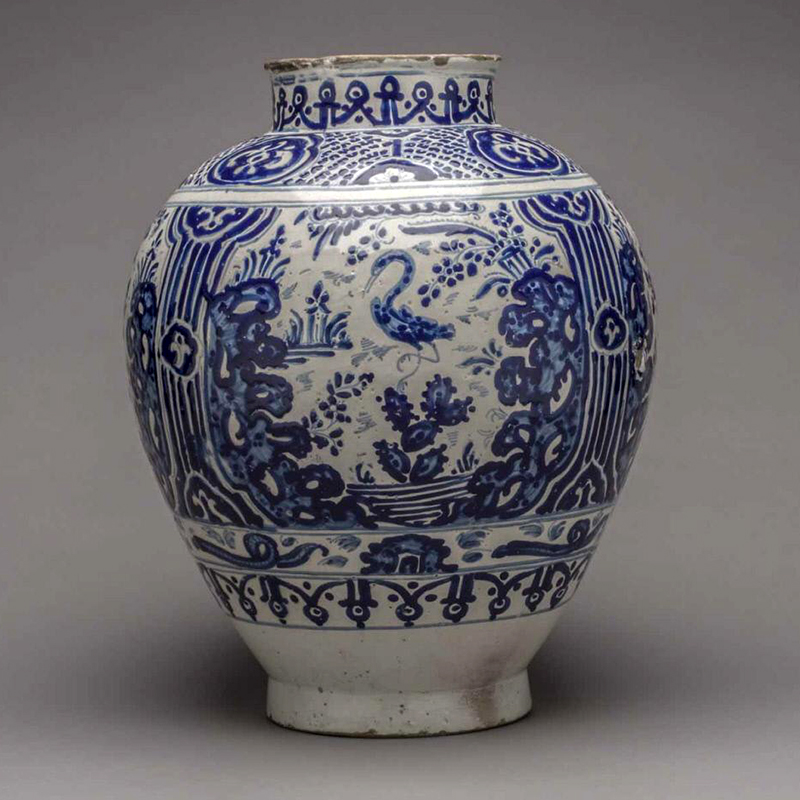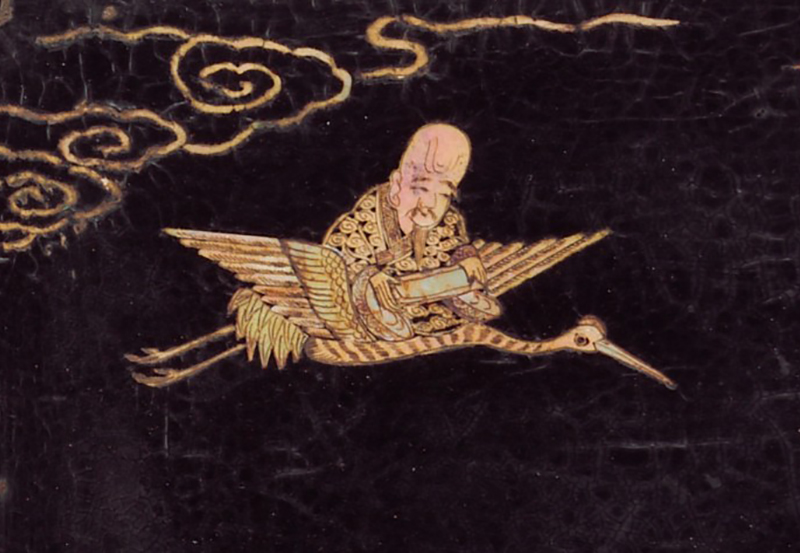The Crane and the Nopal: Aztec Memory and Chinese Imagery in Talavera Poblana
by Juliana Fagua Arias
In the mid-16th century, potters from Puebla, Mexico, developed a type of tin-glazed earthenware known today as Talavera Poblana. Various cultural developments, including the migration of Spanish ceramicists, the transpacific trade between the Philippines and Mexico, and the interactions between colonists and Indigenous populations in the Americas, resulted in the synthesis of Hispano-Muslim, Chinese, and Native American designs in these ceramics. One motif present in at least two Talavera Poblana ceramics (figures 1 and 2) at the Hispanic Society in New York City, a crane on top of a nopal cactus, combines a symbol of a threatened but enduring native past—the nopal cactus—with an image representing emerging trade routes with Asia—the crane.
The nopal cactus refers to Tenochtitlan, the capital of the Aztec empire destroyed in 1521 by the Spanish conquistadores. In Pre-Contact art, the nopal was usually depicted with an eagle on top (figure 3). The motif of the crane arrived with Chinese porcelain, where it was placed on top of a pine tree symbolizing longevity (figure 4). By replacing the eagle with the crane, Mexican potters memorialized the glorious Aztec past while acknowledging a nascent colonial identity influenced by Mexico’s commercial ties with Asia. The creation of hybrid motifs such as this one also reflected an increasingly hybrid society born out of the transatlantic and transpacific trade and migrations.
The Mexican tradition of Talavera Poblana originated with the Spanish migration to the Americas in the early 16th century. Immigrants brought ceramics from cities like Talavera de la Reina and Valencia, which were strongly influenced by Islamic tin-glazed pottery. In the Americas, these Hispano-Muslim styles merged with the blue-and-white Chinese porcelain coming from Asia via the Spanish colony of the Philippines. Although initially banned from entering the pottery guild in Puebla, Native American ceramicists became part of the Talavera workshops, introducing Aztec imagery. From this cross-cultural fusion the “crane and nopal motif” was born.
Both vases at the Hispanic Society depict this motif. Decorative top and bottom scroll bands combining Hispano-Muslim Kufic script, and Chinese rosettes frame four lobed central panels displaying the crane and nopal. The crane is seen in profile perched on top of a nopal cactus in front of a body of water, encircled by floral shapes, curved lines, and interspersed dots. Both vessels share the blue-and-white color palette of Chinese porcelain and employ the aborronado and silhouette painting styles, combining dots with free-flowing brushwork.
Mexican potters may have replaced the Aztec motif of the eagle with the Chinese crane in recognition of their formal similarities. In their original contexts, both birds were traditionally depicted perched on top of a plant. Surprisingly, both motifs share a similar symbology in their respective cultures. In China, cranes are a symbol of longevity, linked to long life through their role as carriers of the immortals (figure 5).1 1 The crane’s white feathers symbolized the white hair of the elderly2 and were also often depicted on top of long-lived and evergreen pine trees with the mythical peaches of immortality that grow in the orchard of Xiwangmu, the Queen mother of the West.3
Figure 5. Tray with Daoist figures, 16th century, China. Black lacquer with mother-of-pearl inlay; basketry sides. The Metropolitan Museum of Art, New York, Purchase, Barbara and William Karatz Gift, 2006, 2006.238.
For Indigenous cultures, the Pre-contact symbol of the eagle on top of a nopal cactus refers to the foundation of Tenochtitlan, the Aztec capital established in 1325 in the middle of Lake Texcoco in the valley of Mexico. The myth surrounding the capital’s establishment relays that their patron deity, Huitzilopochtli, told the Aztecs’ ancestors to leave their ancestral home of Aztlan and build a new city in the place where they saw an eagle atop a cactus growing from a rock. In Pre-contact art, the eagle is also seen biting into a cactus fruit as a symbolic representation of Huitzilopochtli devouring a human heart (figure 6).4
Thus, there are multiple similarities between the Aztec symbol of the eagle on top of the nopal and the Chinese symbol of the crane on top of the pine tree. They are both auspicious―the crane and pine tree of longevity, and the eagle and nopal cactus of a sense of place and home. Also, both birds are usually depicted with a fruit, peaches in the case of the crane, and the cactus fruit in the case of the eagle. Both symbols are also related to a mythical, paradise island. The crane invokes the island of the immortals, the orchard of Xiwangmu, the Queen mother of the West. The Aztec eagle invokes Aztlan and the promised land of Tenochtitlan.
The “crane and nopal” motif is significant, among other things, because it connects the ancient city of Tenochtitlan to colonial Mexico. Just as Tenochtitlan was considered the center of the Aztec empire where all members converged and paid tribute, colonial Mexico was the center where the proverbial East and West, Asia and Europe, met during the early modern period. Art historian Sonia Lombardo noted that the Main Temple of Tenochtitlan was the symbolic container of valuable objects from distant parts of the empire.5 Of the offerings that archaeologists have uncovered, 80% are from frontier provinces under Aztec domination. Through this act, the lords of Tenochtitlan integrated objects from the periphery of their empire to their central shrine, symbolically engulfing them to reinstate the power of the capital.6 Likewise, replacing the figure of the eagle with that of the crane could be interpreted as an Indigenous maker’s act to integrate the objects arriving from the periphery, that is, Asia, into an emerging Mexican culture. An act of engulfment that made the colony stronger, expressed resilience in the face of colonization, and memorialized the Aztec empire, the “crane and nopal” symbol is more than a decorative motif, it is a mnemonic device that announces the city’s resolution to fashion a new identity tied to the incoming wave of Asian goods. In this motif, the once undefeated eagle of the Aztec empire has taken flight, and in its place a crane has arrived, the symbol of a new era.
Juliana Fagua Arias is a contributing writer for The Decorative Arts Trust Bulletin.
1 Welch, Patricia Bjaaland. Chinese Art: A Guide to Motifs and Visual Imagery, 1st ed (North Clarendon, VT: Tuttle Pub, 2008).
2 Denney, Joyce. “Longevity in Chinese Art.” The Metropolitan Museum of Art, Heilbrunn Timeline of Art History, Essay, August 2010, https://www.metmuseum.org/toah/hd/long/hd_long.htm.
3 Denney.
4 “Eagle Relief | Toltec,” The Metropolitan Museum of Art, accessed December 9, 2020, https://www.metmuseum.org/art/collection/search/307598.
5 Lombardo, Sonia. “Desarrollo Urbano de México-Tenochtitlan.” (Ciudad de México, México, Escuela Nacional de Antropología e Historia, 1972).
6 Carrasco, David. “City as Symbol in Aztec Thought: The Clues from the Codex Mendoza.” History of Religions 20, no. 3 (1981): 220.
About The Decorative Arts Trust Bulletin
Formerly known as the "blog,” the Bulletin features new research and scholarship, travelogues, book reviews, and museum and gallery exhibitions. The Bulletin complements The Magazine of the Decorative Arts Trust, our biannual members publication.














